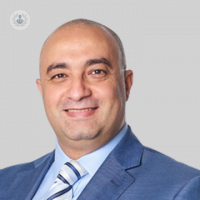Exploring ankle instability: part 2
Escrito por:Participating in sport can put a huge strain on our bodies, particularly on the ankles, leading to ankle instability. In the second article of a two-part series, renowned consultant orthopaedic surgeon Mr Hisham Shalaby discusses how to strengthen the ankle, and when to consider seeking medical treatment for the condition.

How can I strengthen my ankles and improve stability to prevent injuries?
Maintaining good muscle strength and staying active are crucial factors in preventing injuries to any joint. Additionally, managing weight is essential for joint health. Another specific consideration is the prevention of excessively tight calf muscles.
The tightness of the calf muscles places undue pressure on the ankle joint and increases the likelihood of injuries. Fortunately, various exercises can be employed to strengthen the muscles surrounding the ankle joint. Physiotherapy is instrumental in guiding patients through exercises, often incorporating therabands, to enhance tendon strength around the ankle. Balance exercises and proprioceptive training are also recommended, as they contribute to overall joint stability.
These exercises collectively play a significant role in improving and maintaining joint stability, reducing the risk of injuries.
Are there specific exercises or physical therapy routines recommended for ankle stability?
In Scotland, in collaboration with our physiotherapy colleagues, we have developed a national protocol for the rehabilitation of lateral, ligament injuries. These are the most common ligament injuries of the ankle.
This protocol involves core muscle strengthening, gait training, calf stretching exercises, range of movement exercises, and targeted strengthening routines for both the inner tendons, specifically the tibialis posterior, and the outer tendons, namely the peroneal tendons. The progression extends to include proprioceptive exercises, focusing on balance enhancement. There are also different protocols for the rehabilitation following surgery to repair ankle ligaments.
Additionally, distinct protocols have been established for rehabilitation post-surgery, particularly for cases involving the repair of ankle ligaments.
When should I consider seeking medical evaluation or treatment for chronic ankle instability?
If, following an ankle injury, conservative measures such as rest and physiotherapy prove ineffective, and the ankle remains weak or prone to giving way, or notably, pain on the outer aspect of the joint and a lack of trust in the ankle's stability, leading to feelings of insecurity or the perception that the ankle may give way, these are the main indicators that you should seek medical attention.
If you have sustained an injury to the ankle, and after conservative treatment with rest and physiotherapy, the ankle remains weak or is prone to giving way, leading to feelings of insecurity or the perception that the ankle may give way you should seek medical attention.
Some people may resort to strapping their ankle during physical activities or sports due to a perceived lack of trust in the joint. If any of these symptoms are present, it is advisable to consult a foot and ankle specialist with expertise in sports injuries, as these signs may signify ankle instability.
Unfortunately, an unstable ankle poses the risk of further injury and cumulative damage, potentially leading to secondary arthritis in the joint. Surgical intervention to repair ankle ligaments emerges as a highly rewarding orthopaedic procedure, promptly restoring joint stability and averting cumulative damage and secondary arthritis.
In cases where a young, fit, and healthy patient experiences ongoing pain or an inability to trust their ankle, surgery is strongly recommended.
If you are suffering from ankle instability and would like to book a consultation with Mr Shalaby, do not hesitate to do so by visiting his Top Doctors profile today


